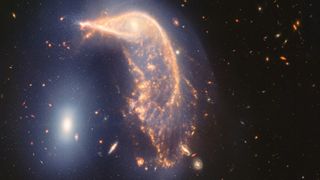
The stunning Penguin and Egg galaxies, seen in this new James Webb Space Telescope image, have been slowly colliding for tens of millions of years.
(Image credit: NASA, ESA, CSA, STScI)
What it is: The galaxy duo Arp 142, also known as “the Penguin” and “the Egg”
Where it is: About 325 million light-years from Earth, in the constellation Hydra
When it was shared: July 12, 2024, the two-year anniversary of the James Webb Space Telescope’s first image release
Why it’s so special: After two years of operations, the James Webb Space Telescope (JWST) has zoomed in on the oldest stars in the known universe, uncovered tantalizing alien planets that could harbor life, challenged leading theories of cosmology — and now, to celebrate its anniversary, even dabbled in bird-watching.
In the cutting-edge telescope’s latest image, JWST reveals the clearest view ever of Arp 142, a pair of intermingling galaxies resembling a cosmic penguin guarding its brilliantly shining egg. The larger Penguin galaxy (named NGC 2936) owes its warped appearance to more than 25 million years of gravitational friction with its eggy companion (NGC 2937), which will one day collide and merge with its neighbor entirely.
The Penguin began its life as a spiral galaxy like our Milky Way, according to NASA. But, as many of us on Earth know, parenthood has a way of changing you. As the massive Egg orbits at about 100,000 light-years away, the Penguin gets bent ever further out of shape. What was once the spiral galaxy’s dense center is now the Penguin’s gleaming eye; its once-symmetrical spiral arms now stretch into a beak, back and tail. In thinner regions, like the Penguin’s beak and tail, gas and dust squish together to form new stars.
Related: James Webb telescope confirms there is something seriously wrong with our understanding of the universe
Get the world’s most fascinating discoveries delivered straight to your inbox.
A full-size photo of the Penguin and Egg galaxies. (Image credit: NASA, ESA, CSA, STScI)
The smaller Egg, glowing brightly to the Penguin’s left, is a densely packed elliptical galaxy that has not changed much during its long galactic dance, according to NASA. Although the Egg looks far smaller than the Penguin, the two galaxies likely contain virtually the same amount of mass, which explains why the Egg hasn’t already been snapped up by the larger Penguin. The final merger of the Penguin and the Egg is likely millions of years away, NASA added.
The new image combines data from JWST’s Near Infrared Camera and Mid-Infrared Instrument, which together reveal a wide range of light that is normally invisible to human eyes. Using these same instruments, JWST has pulled back the curtain on some of the universe’s oldest, most distant structures, yielding a bounty of new information about the origins of stars, galaxies and the universe itself. And its mission has only just begun.
“In just two years, Webb has transformed our view of the universe,” Mark Clampin, director of the Astrophysics Division at NASA Headquarters in Washington, said in a statement. “Webb is providing insights into longstanding mysteries about the early universe and ushering in a new era of studying distant worlds. … It has never been more possible to explore every facet of the universe.”
Brandon is the space/physics editor at Live Science. His writing has appeared in The Washington Post, Reader’s Digest, CBS.com, the Richard Dawkins Foundation website and other outlets. He holds a bachelor’s degree in creative writing from the University of Arizona, with minors in journalism and media arts. He enjoys writing most about space, geoscience and the mysteries of the universe.
>>> Read full article>>>
Copyright for syndicated content belongs to the linked Source : Live Science – https://www.livescience.com/space/astronomy/space-photo-of-the-week-warped-penguin-galaxy-spotted-by-jwst-is-waddling-toward-certain-doom
